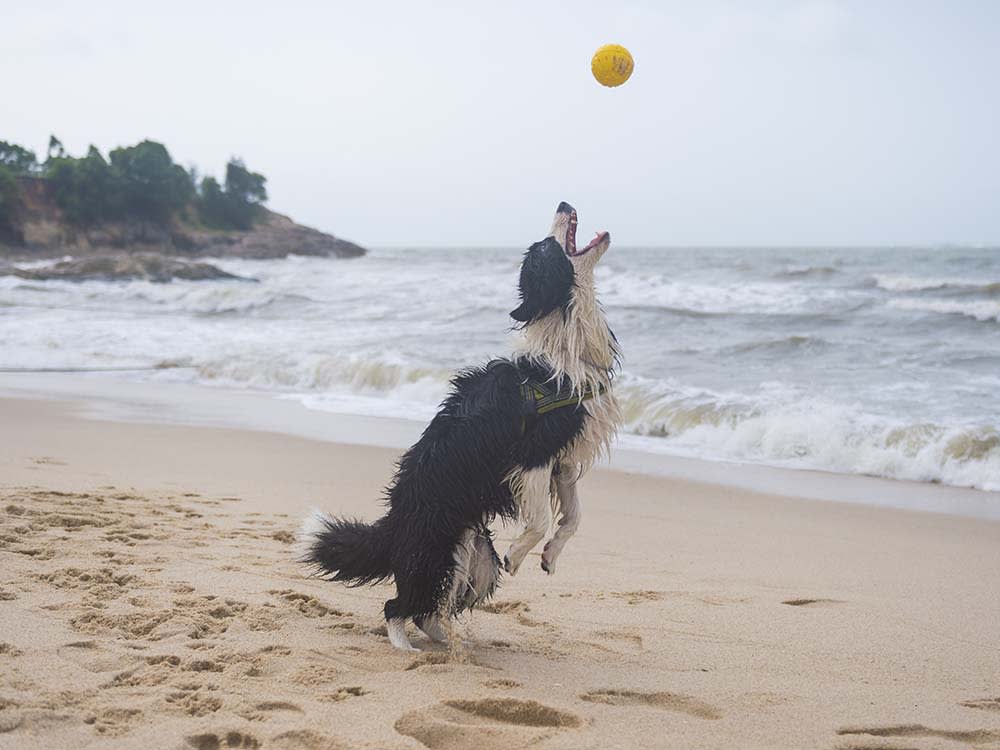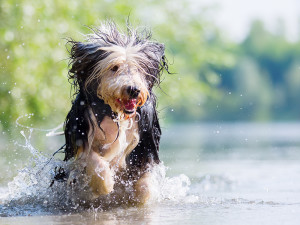
Share Article
Summer (hopefully) approaches and with that comes the lure of day trips to the Great British Seaside, but did you know that lots of the UK’s beaches have rules in place from May to September about what dogs can and can’t do? We break down everything you need to know about beach rules for dogs this summer.
What are the rules?
The majority of beaches across the country allow people to walk their dogs from 1 October to 30 April every year. But during the summer months, some local councils introduce rules and regulations around dogs on the beach, which can vary depending on the area. Some local councils have enforced full bans, with others introducing partial bans that require dogs to remain on leads or stick to promenades rather than on the actual beach. These rules have been enforced via Public Spaces Protection Ordersopens in new tab (PSPO), which are government rules related to what dogs can do in certain areas.
If dog parents are caught ignoring the specific rules in place for that beach, they could be given a £100 fine on the spot or face a fine of up to £1,000 if it goes to court.
Some areas still have dog-friendly beaches in addition to beaches with bans, so your dog’s dreams of frolicking in the sand and chasing waves are not totally ruined – you just have to do your homework to find the right spots.
Why do the rules exist?
There are a number of reasons that local councils might enforce bans or rules on dogs at the beach, including:
Disruption to beachgoers now that beaches are more busy during the summer tourist season.
Dog poo and urine: this can affect water quality and could threaten the Blue Flag or Seaside Award status of a beach. Also, sadly we can’t always rely on dog parents to pick up after their pups and accidentally touching a pile of dog poo while you’re trying to relax on the sand is not the nicest way to spend a day at the beach.
Safety of children: while many dogs are great with kids, the influx of children and babies on the beach means that it can often be safer for dogs to be kept on a lead or off the beach entirely, rather than an overexcited pup bounding over to a small child and knocking them down. See also: children eating/touching dog poo.
Protecting wildlife: birds perceive dogs as predators and each time they are put to flight while feeding or resting, they waste vital energy reserves which are essential for birds to successfully rear their young or for migration – both of which happen during spring and summer months.
How to check the rules of the beach you’re visiting
With around 1,500 beaches across the length and breadth of the UK’s coastline, it would be impossible to list out the rules for each beach, but thankfully The Beach Guideopens in new tab is the perfect resource. Check out their comprehensive list of rules for hundreds of beaches in England, Northern Ireland, Scotland and Wales.
Most beaches in the UK will either have a website or a dedicated section on the website of their local council, so if you have a location in mind, it’s as simple as googling ‘rules for dogs on [insert beach name]’. For instance, searching this using ‘Brighton beach’ pulls up the following information from Brighton & Hove City Council: “Dogs are permitted on all beaches in Brighton & Hove from 1 October to 30 April. The rest of the year, dogs are only permitted on beaches listed as dog-friendly beaches. When you take your dog onto the beach they must be supervised and under control at all times and any fouling must be cleared immediately.”
And a further search for ‘dog-friendly beaches Brighton’ allows you to explore a helpful mapopens in new tab provided by the council.
Many beaches will also have the rules sign-posted, and if in doubt, ask someone else walking their dog nearby or follow what the majority of other dog parents seem to be doing as locals will be familiar with the rules.
How can I keep my dog safe at a dog-friendly beach?
So you’ve found the perfect dog-friendly beach and you and your pup are heading out for a day of sun, sea and sand. Now, it’s important to make sure you keep you’re prepared and aware of how to keep your dog safe at the beach.
Pack the essentials
Bucket and spade aside, there are a few things you should take with you to the beach when you head out with your pup.
Collapsible water and food bowls: if you’re planning a long walk (maybe even followed by an afternoon at the pub), you should bring both food and water bowls with you, plus some fresh water in a bottle to top up the bowl if you won’t have access to drinking water on the walk. If you’re going to be out for a long time during your dog’s usual mealtimes, bring some food with you, too, so as not to disrupt their schedule.
Toys and balls: get your dog’s energy out by bringing toys you can throw for them, tug toys for a bit of rough and tumble in the sand, and puzzle feeders and Kongs if you’re going to need to keep them busy during your post-walk activity.
Weather-appropriate gear: is it going to be cold, hot, raining? Probably all three in quick succession in the UK. Either way, make sure your pup is equipped with everything they need to face the elements, including a towel to dry them off after a dip in the sea.
Dog life jacket: while many dogs have a natural instinct to swim, it’s important to remember that not all dogs can swim. Some breeds are also physically better suited to swimming, whereas others might be frightened or have difficulty swimming. If your dog falls into the latter category, make sure they‘re wearing a properly fitted dog life jacket.
Protect paws and ears
Salt can be irritating to paws and skin, too. Rinse salt water and sand from your dog’s coat after swimming. Always clean and dry ears after a swim. Water that remains in ears, especially from the sea, can result in a bacterial ear infection.
Is it safe for dogs to swim in the sea?
In general, it is safe for dogs to swim in the sea – it can be great exercise for them. But before taking them to the water, take note of a few precautions.
Your dog may be a strong swimmer, but large rolling waves can still be very dangerous. Before you take your dog to the beach, it’s important to check the water conditions. Some beaches may have rip currents or other hazards that could be dangerous for dogs. In these conditions, you might want to keep your dog on a lead so that they can’t go out too far.
Beware of other animals and wildlife. Scan both the water and sand for crabs and other marine life, which can be dangerous for dogs. Be aware of sea lice that can cause itchy red bumps on dogs. Prevent your pup from rolling in or eating anything that could make them sick. Be especially mindful of areas that have a high volume of jellyfishopens in new tab. Another tip: discourage your dog from eating sand when playing fetch at the beach. Too much sand ingested can create an impaction in their intestine causing their intestinal tract to close up.
Monitor salt water ingestion. Your dog may want to lap up the sea water if they’re thirsty, but the salt, bacteria and parasites in the water can make them sick. While at the beach, dogs can get dehydrated quickly in the sun, so it is imperative that you prevent your dog from drinking salt water by providing them with plenty of fresh water. Drinking too much salt water can lead to salt water poisoning, vomiting after swimming and ‘beach diarrhoea’.
Is the weather suitable for a beach day?
While scorching hot days are not exactly a common occurrence in the UK, they do happen. Just like people, dogs are at risk for heatstroke and dehydration when temperatures rise. If you’re uncomfortable in the sun, your dog probably is, too. Make sure they always have access to fresh water and shade when outside, and you can also give them ice-filled Kongs or a frozen water bottle to keep them cool.
Sunscreen: if it’s a particularly hot day, limit your dog’s exposure during peak sun hours (between 10am and 3pm) and apply doggy sunscreenopens in new tab 30 minutes before going outside.
Protect their paws from hot sand: hot sand (and pavement) can easily exceed comfortable temperatures for delicate paw pads leading to blisters. If the sand is too hot for you to walk barefoot, then it’s too hot for your pup’s paw pads. Save your beach trip for a cooler day, or go in the early morning or late evening to avoid the heat.
Heat-stroke: running on the sand is strenuous exercise, and this can easily lead to heat-stroke in dogs. And never, ever leave your dog unattended in your car in the summer months – even while you’re loading and unloading your car at the beach. Heat-stroke and death can occur within minutes even in warm temperatures.
With all this in mind, there’s no reason you would need to send your dog a ‘Wish You Were Here’ postcard from the seaside – they can enjoy it, too. Just be sure to check the rules before heading out!
Ro Elfberg
Ro is Kinship UK’s Senior Editor. She has previously written and copy-edited for British Vogue, Glamour and DICE. When she’s not being manipulated into dishing out Dreamies to Kobe the cat, she spends her free time trying to convince her snake, Butters, to wear a tiny hat.
Related articles
![]()
10 Best Dogs for Life by the Sea
Is your dog’s job ‘just beach’?
![Man walking his dog on a pavement]()
Does It Matter Where I Walk My Dog?
We delve into the age-old debate
![woman on the bus with her dog on the chair]()
What to Do if Your Dog Has a Toilet Accident in Public
An awkward reality for many of us
![Woman holding a beagle in warm dappled summer light]()
You’ve Got a Summer-Lovin’ Pup. Here’s How to Keep Them Safe
Some like it hot (but not most dogs). Here are the season’s health hazards, from fleas to grass seeds
![Avoid heat stroke in dogs by sprinkling in the backyard with your dog]()
Heat-Stroke in Dogs: Signs, Treatment & Prevention Expert Advice
How to take precautions for your pup when temperatures rise






